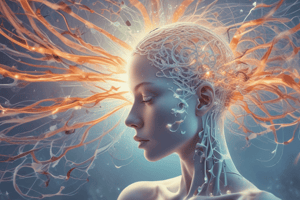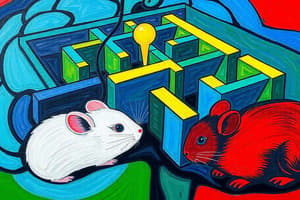Podcast
Questions and Answers
What does transcranial magnetic stimulation (TMS) primarily investigate?
What does transcranial magnetic stimulation (TMS) primarily investigate?
- Neurotransmitter levels in various brain regions
- Causal involvement of brain regions in cognitive functions (correct)
- The anatomical structure of the brain
- Differences in brain activity between genders
Which brain region was targeted in the Kosslyn et al. TMS study during a perception/imagery task?
Which brain region was targeted in the Kosslyn et al. TMS study during a perception/imagery task?
- Parietal lobe
- Occipital lobe (correct)
- Frontal lobe
- Temporal lobe
What is the primary characteristic of a drug that differentiates it from endogenous compounds?
What is the primary characteristic of a drug that differentiates it from endogenous compounds?
- It does not alter physiological processes
- It is not necessary for normal cellular functioning (correct)
- It always has a positive effect on behavior
- It is produced naturally in the body
Which of the following statements accurately describes drug effects?
Which of the following statements accurately describes drug effects?
Which of the following correctly outlines a step in pharmacokinetics?
Which of the following correctly outlines a step in pharmacokinetics?
Which method of drug administration allows substances to reach the brain within a few seconds?
Which method of drug administration allows substances to reach the brain within a few seconds?
What does the term 'site of action' refer to in pharmacology?
What does the term 'site of action' refer to in pharmacology?
Which technique provides a good time course of cognitive processes affected by certain factors?
Which technique provides a good time course of cognitive processes affected by certain factors?
What drives Na+ ions to move into the neuron?
What drives Na+ ions to move into the neuron?
What is the role of the sodium-potassium pump in neurons?
What is the role of the sodium-potassium pump in neurons?
During depolarization, what primarily occurs in the neuron?
During depolarization, what primarily occurs in the neuron?
What does the term 'electrostatic pressure' refer to in neuron function?
What does the term 'electrostatic pressure' refer to in neuron function?
What is the resting membrane potential of a neuron at rest?
What is the resting membrane potential of a neuron at rest?
What is the function of the intracellular fluid in a neuron?
What is the function of the intracellular fluid in a neuron?
Which ions are primarily found in the extracellular fluid outside of a neuron?
Which ions are primarily found in the extracellular fluid outside of a neuron?
What is a key function of diffusion in the context of ion movements in neurons?
What is a key function of diffusion in the context of ion movements in neurons?
What effect do EPSPs have on a neuron's membrane potential?
What effect do EPSPs have on a neuron's membrane potential?
What is the primary role of IPSPs in neuronal behavior?
What is the primary role of IPSPs in neuronal behavior?
When both EPSPs and IPSPs are active, what determines whether a neuron will fire an action potential?
When both EPSPs and IPSPs are active, what determines whether a neuron will fire an action potential?
How can inhibitory neurons paradoxically lead to increased neuronal excitation?
How can inhibitory neurons paradoxically lead to increased neuronal excitation?
What happens if excitatory synapses dominate in a neuron?
What happens if excitatory synapses dominate in a neuron?
What two mechanisms terminate postsynaptic potentials quickly?
What two mechanisms terminate postsynaptic potentials quickly?
In the context of neural integration, what role do EPSPs and IPSPs play?
In the context of neural integration, what role do EPSPs and IPSPs play?
What occurs when EPSPs and IPSPs cancel each other out?
What occurs when EPSPs and IPSPs cancel each other out?
What is the role of calcium ions in neurotransmitter release?
What is the role of calcium ions in neurotransmitter release?
Which process describes the release of neurotransmitters from synaptic vesicles?
Which process describes the release of neurotransmitters from synaptic vesicles?
How do the ready-release pool and reserve pool of vesicles differ?
How do the ready-release pool and reserve pool of vesicles differ?
What is the process called when vesicles merge fully with the membrane and new vesicles pinch off?
What is the process called when vesicles merge fully with the membrane and new vesicles pinch off?
What distinguishes ionotropic receptors from metabotropic receptors?
What distinguishes ionotropic receptors from metabotropic receptors?
What effect does Botox have on muscle contraction?
What effect does Botox have on muscle contraction?
What happens when neurotransmitters bind to ionotropic receptors?
What happens when neurotransmitters bind to ionotropic receptors?
Which of the following accurately describes the recycling pool of vesicles?
Which of the following accurately describes the recycling pool of vesicles?
How do nicotinic receptors differ from muscarinic receptors?
How do nicotinic receptors differ from muscarinic receptors?
Which of the following describes the role of neostigmine in myasthenia gravis?
Which of the following describes the role of neostigmine in myasthenia gravis?
What is the primary outcome of depolarization in the presynaptic membrane?
What is the primary outcome of depolarization in the presynaptic membrane?
Which neurotransmitter systems are classified as monoamines?
Which neurotransmitter systems are classified as monoamines?
What is a key feature of peptide neurotransmitters compared to classical neurotransmitters?
What is a key feature of peptide neurotransmitters compared to classical neurotransmitters?
What is the role of endocannabinoids in the lipid neurotransmitter system?
What is the role of endocannabinoids in the lipid neurotransmitter system?
What characterizes the speed of activation in muscarinic receptors?
What characterizes the speed of activation in muscarinic receptors?
Which receptors inhibit the production of cyclic AMP?
Which receptors inhibit the production of cyclic AMP?
What best describes the action of myosin during muscle contraction?
What best describes the action of myosin during muscle contraction?
What role do motor units play in muscle activity?
What role do motor units play in muscle activity?
Which process leads to increased muscle force during a twitch?
Which process leads to increased muscle force during a twitch?
What occurs during tetanus in muscle contraction?
What occurs during tetanus in muscle contraction?
What is the primary function of isometric contraction?
What is the primary function of isometric contraction?
Why do muscles always pull rather than push?
Why do muscles always pull rather than push?
During the relaxation phase of muscle contraction, what happens to calcium?
During the relaxation phase of muscle contraction, what happens to calcium?
What is the consequence of prolonged muscle activity regarding ATP?
What is the consequence of prolonged muscle activity regarding ATP?
Flashcards
Diffusion
Diffusion
The tendency of ions to move from areas of high concentration to low concentration.
Electrostatic Pressure
Electrostatic Pressure
The attraction or repulsion of charged particles. Opposites attract, and like charges repel.
Intracellular Fluid
Intracellular Fluid
The fluid inside a neuron, containing potassium as the main positive ion and large, negatively charged organic anions (A-).
Extracellular Fluid
Extracellular Fluid
Signup and view all the flashcards
Sodium-Potassium Pump
Sodium-Potassium Pump
Signup and view all the flashcards
Resting Potential
Resting Potential
Signup and view all the flashcards
Threshold Trigger
Threshold Trigger
Signup and view all the flashcards
Depolarization
Depolarization
Signup and view all the flashcards
Exocytosis
Exocytosis
Signup and view all the flashcards
Kiss and run
Kiss and run
Signup and view all the flashcards
Merge-and-recycle
Merge-and-recycle
Signup and view all the flashcards
Bulk endocytosis
Bulk endocytosis
Signup and view all the flashcards
Ready-release pool
Ready-release pool
Signup and view all the flashcards
Recycling pool
Recycling pool
Signup and view all the flashcards
Reserve pool
Reserve pool
Signup and view all the flashcards
Receptors
Receptors
Signup and view all the flashcards
Neural Integration
Neural Integration
Signup and view all the flashcards
EPSP (Excitatory Postsynaptic Potential)
EPSP (Excitatory Postsynaptic Potential)
Signup and view all the flashcards
IPSP (Inhibitory Postsynaptic Potential)
IPSP (Inhibitory Postsynaptic Potential)
Signup and view all the flashcards
Excitatory vs. Inhibitory Dominance
Excitatory vs. Inhibitory Dominance
Signup and view all the flashcards
Inhibiting Inhibition
Inhibiting Inhibition
Signup and view all the flashcards
Postsynaptic Potential Termination
Postsynaptic Potential Termination
Signup and view all the flashcards
Reuptake
Reuptake
Signup and view all the flashcards
Enzymatic Degradation
Enzymatic Degradation
Signup and view all the flashcards
What is a Drug?
What is a Drug?
Signup and view all the flashcards
What are Drug Effects?
What are Drug Effects?
Signup and view all the flashcards
What is a Site of Action?
What is a Site of Action?
Signup and view all the flashcards
What is Pharmacokinetics?
What is Pharmacokinetics?
Signup and view all the flashcards
What is a Direct Effect?
What is a Direct Effect?
Signup and view all the flashcards
What is an Indirect Effect?
What is an Indirect Effect?
Signup and view all the flashcards
What is a Half-Life?
What is a Half-Life?
Signup and view all the flashcards
What is an ED50?
What is an ED50?
Signup and view all the flashcards
ACh and Muscle Contraction
ACh and Muscle Contraction
Signup and view all the flashcards
Botox and ACh Release
Botox and ACh Release
Signup and view all the flashcards
Black Widow Venom and ACh
Black Widow Venom and ACh
Signup and view all the flashcards
Nicotinic Receptors
Nicotinic Receptors
Signup and view all the flashcards
Muscarinic Receptors
Muscarinic Receptors
Signup and view all the flashcards
Myasthenia Gravis
Myasthenia Gravis
Signup and view all the flashcards
Monoamine Neurotransmitters
Monoamine Neurotransmitters
Signup and view all the flashcards
Dopamine Receptors
Dopamine Receptors
Signup and view all the flashcards
Cross-Bridge Cycle
Cross-Bridge Cycle
Signup and view all the flashcards
Muscles Always Pull
Muscles Always Pull
Signup and view all the flashcards
Motor Unit
Motor Unit
Signup and view all the flashcards
Muscle Twitch
Muscle Twitch
Signup and view all the flashcards
Temporal Summation
Temporal Summation
Signup and view all the flashcards
Tetanus
Tetanus
Signup and view all the flashcards
Isotonic Movement
Isotonic Movement
Signup and view all the flashcards
Isometric Movement
Isometric Movement
Signup and view all the flashcards
Study Notes
Reading Notes - Carlson & Birkett Chapter 2
- Central Nervous System (CNS):
- Composed of the brain and spinal cord
- Communicates with body through nerves
- Transmits messages from sensory organs to brain, and from brain to muscles/glands.
- Contains various interneurons for analysis of information
- Local interneurons: form circuits with nearby neurons for analysing small pieces of information
- Relay interneurons: connect local circuits in one brain region to those in others.
- Peripheral Nervous System (PNS):
- Composed of nerves and most sensory organs
- Carries sensory information from environment (light, sounds, odors, tastes)
- Controls motor behavior needed for muscle contractions
Neuron Structure
- Basic unit of the nervous system, responsible for information processing and transmission
- Soma (cell body): contains nucleus and machinery for cell processes
- Dendrites: receive messages from other neurons
- Axon: long, thin tube transmitting information from cell body to terminal buttons.
- Kinesin: protein for anterograde transport (from soma to terminal buttons)
- Dynein: protein for retrograde transport (from terminal buttons to soma)
- Terminal buttons: release neurotransmitters to other neurons
- Myelin Sheath: insulation for efficient signal transmission
- Terminal Buttons: release neurotransmitters into synapse
Supporting Cells in Nervous System
- Glial Cells (CNS): crucial supporting cells in the CNS
- Provide structure/support to neurons
- Regulate nutrient supply to neurons
- Remove pathogens and dead neurons
- Involved in growth, repair and development
- Astrocytes: physical support and maintain proper chemical environment
- Oligodendrocytes (CNS) v Schwann cells (PNS): forms myelin sheath
- Microglia: smallest glial cells, act as phagocytes - protecting brain against invaders
- PNS: Schwann cells, support and produce myelin, important for nerve repair
Neural Communication (Reflex)
- Neural Communication: Sensory neuron detects painful stimulus -> signals travels down axons to spinal cord -> terminal buttons release excitatory NTs -> interneuron -> motor neuron signals to muscles -> contraction
- Inhibition: Signals from brain influence inhibitory interneurons -> reduces motor neuron activity in cases like object handling
Studying That Suits You
Use AI to generate personalized quizzes and flashcards to suit your learning preferences.




